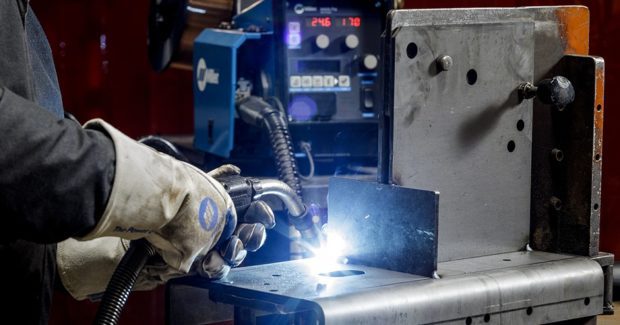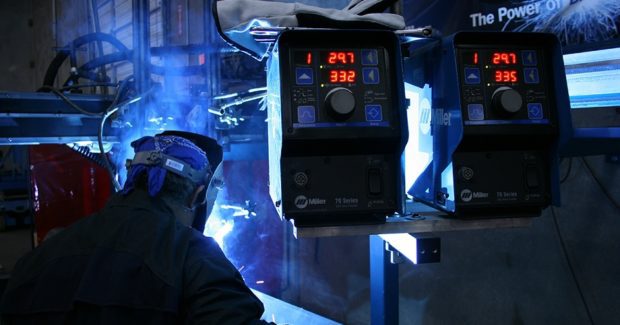Five Best Practices for Multi-Material Welding in Manufacturing
To stay competitive, more shops face the challenges of welding many different types of materials. To reduce setup times and help their operators produce high-quality welds, they must move beyond basic options and invest in advanced capabilities that can have a big impact on the bottom line.
Posted: July 29, 2019
Carbon steel base materials are frequently used in many welding applications, offering easy weldability and affordability. But aluminum and stainless steel – and even materials like titanium and silicon bronze – are becoming more common in fabricating and manufacturing. Welding many types of materials can require an investment in more welding equipment and often takes more time for setup and changeover between applications. As more manufacturers and contractors are faced with the challenges of welding a wider range of materials, they want solutions that help save time and money. There are welding technologies and processes that make it easier and more efficient for operations to produce high-quality welds, no matter the material being welded. The material evolution in the manufacturing industry stems from several factors. In some market sectors, there is a push toward lighter weight and corrosion-resistant materials and components, which is driving the use of aluminum, high-strength steels and stainless steel. In addition, a growing manufacturing economy allows contractors and OEMs to take on more contracts – and a wider variety of jobs.
If an operation doesn’t have the right welding equipment, the need to weld different materials can present challenges because some metals require different techniques or processes to achieve the best results. Constant voltage (CV) gas metal arc welding (GMAW or MIG) is often a good choice when an operation is welding only carbon steel, but aluminum and stainless steel are better-suited for GMAW-P (pulsed MIG welding). The following best practices will help you choose welding systems specifically designed for different types of materials. The right solutions also help you gain flexibility and efficiency while producing high-quality welds on different metals.
TIP 1: AVOID THE BASIC FEEDER OPTION
When selecting a wire feeder for welding different materials, it pays to go beyond the basic option. Wire feeders with more advanced technologies can save time and improve productivity, especially in welding operations that frequently switch back and forth between materials. Some companies have separate welding cells or even duplicate a welding system to avoid the time to change over different materials – one cell for welding aluminum and another for welding carbon steel, for example. Using a dual feeder system could eliminate the need for separate welding cells by material type. For example, with a dual feeder solution, one side can be set up for aluminum and the other side can be set up for carbon steel or stainless steel. Welders can easily switch between sides, eliminating the need to change out the filler metal and shielding gas every time the material being welded changes. This reduces an operation’s equipment investment and saves floor space because the same welding power source can be used with two wire feeders in the same welding cell, rather than outfitting two separate cells with more equipment.
An integrated system package that includes the power source and wire feeder on one MIG runner cart can save time in setup, free up space on the welding floor and make it easier to move equipment from one cell to another. Because filler metals used for soft alloys such as aluminum, small-diameter stainless and silicon bronze can be more difficult to feed, it’s also recommended to use a push-pull system for smoother wire feeding. More advanced wire feeders let welders save different weld programs, so the correct parameters for specific applications can be easily retrieved with the push of a button. This saves significant time in setup and changeover between material types.
TIP 2: CONSIDER A SWITCH TO PULSED MIG WELDING
When an operation must frequently weld aluminum or stainless steels, choosing a system with pulsed MIG capabilities can help welders produce high-quality welds and reduce rework. While aluminum can be welded using the standard CV MIG process, pulsed welding is a much better option for the material because it provides lower heat input and greater arc control – reducing spatter, porosity, and the risk of distortion and burn-through. This results in less rework and improved cycle times, so a shop can produce more parts. Pulsed MIG has many subtle variations in how the arc is controlled. These process variations are referred to as advanced arcs or advanced pulsed waveforms. Advanced arcs for pulsed welding are typically smoother and more forgiving. When there is a lack of welder experience or consistency, these arcs can compensate for varying travel speeds and contact-tip-to-work distances, which makes it easier to consistently produce quality welds.
TIP 3: LOOK FOR EASY-TO-USE TECHNOLOGY
Setting the right welding parameters to ensure the proper bead profile and penetration can be more difficult with materials like aluminum and stainless steel. Look for welding technologies and equipment designed to make this easier. Some welding power sources assist welders in setting proper parameters. The welder simply inputs the material type and thickness, along with the wire type and size, and the machine will set the necessary parameters to produce a quality weld. In addition, other technologies can provide benefits for specific materials. A power source with crater fill and hot start features is helpful when welding aluminum, providing better arc starting and stopping capabilities. Typically, the start of the weld is very cold, which can result in cold lap and a higher crown on the weld face on the first weld pass. A machine with hot start helps establish the arc and immediately provides good fusion, while the crater fill feature helps prevent weld cracking by properly filling in the ends of the weld.
TIP 4: SELECT THE RIGHT FILLER METALS
Beyond choosing the right power source and wire feeder for the job, it’s also important to follow some best practices for filler metals and material storage. Selecting the right filler metal for the application and base material is critical. There are many different types of aluminum and stainless steels, so be sure to match the filler metal to the mechanical and chemical properties of the base material. Proper storage is especially critical for aluminum. When aluminum is exposed to moisture and not allowed to dry – or the oxide isn’t removed – it can result in hydrogen in the weld, causing porosity. Store aluminum in a clean, dry place, and properly clean your base material to remove all oxides before welding.
TIP 5: USE YOUR CONSUMABLES WISELY
The liner and consumables being used to weld steel should not be used to also weld aluminum. This can result in cross-contamination or wire feeding issues. Carbon steel generally requires a steel liner, while aluminum uses a plastic or Teflon liner with tighter tolerances. You also need to use the correct drive rolls and feeding guides for the type of filler metal being used.
As more shops are tasked with welding many different types of materials, there are welding technologies that can help. Advanced wire feeders and processes such as pulsed MIG are designed to save time in setup and help operators produce high-quality welds. Going beyond the basic options and investing in these additional capabilities can have a big impact on the bottom line.


















